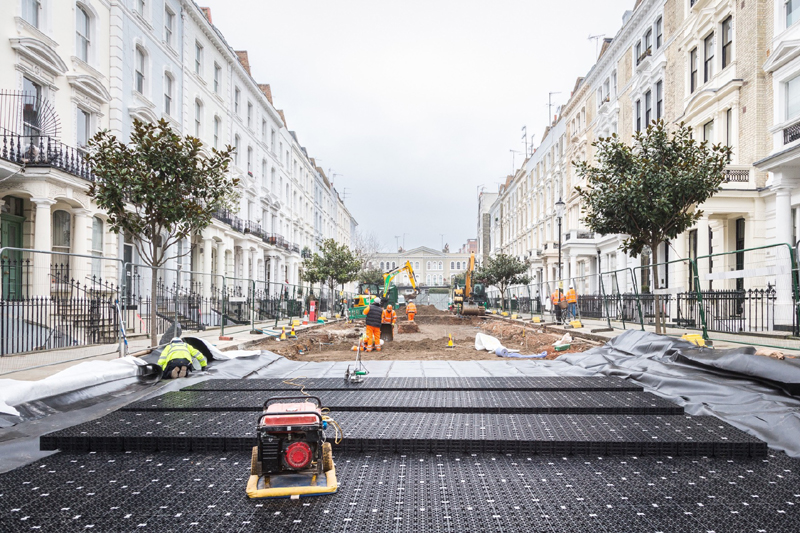
As the impact of climate change becomes ‘unequivocal’, the need to evolve how we design and build homes and urban landscapes does too. Mark Shearer, Business Development Director for Key Accounts – Merchants at Polypipe Civils and Green Urbanisation, explains how merchants can support the shift to more sustainable, resilient and ‘beautiful’ communities by working with key partners.
In recent weeks, the conversation around climate change has never been more prevalent. From flooding and heat waves across Europe and the USA alongside the United Nations’ landmark review of human influence on the world’s warming, climate change has barely left the headlines.
The past few months have also seen major developments in government environmental policy. The Environment Bill is one such piece of legislation, focused on building and preserving an environment able to withstand the impact of climate change, population growth and future pressure on resources.
Additionally, in late July, the Housing Secretary, Robert Jenrick, announced an update to the National Planning Policy Framework “to enshrine quality, beauty and sustainability in the heart of local decision-making”. Jenrick also introduced the National Model Design Code (NMDC) — a toolkit guiding all elements of new developments.
But what does this new legislation mean for merchants and their role in supporting industry to adopt these new policies and more sustainable building practices?
What it means for water
As the UK Government has stated, ‘global collaboration’ is critical to lessen the effects of climate change and this need for cooperation applies to every aspect of construction. Due to their close relationships with solution providers across the built environment, merchants are a pivotal link between the supplier and the customer, on-hand to help specifiers navigating legislative changes and advising on new, innovative products that can help deliver more resilient landscapes.
Water, as our most valuable resource, is essential to building this resilience, and its management is a key area where merchants can provide invaluable support. And as part of the forthcoming Environment Bill and the NMDC, there will be changes to how we use and manage water resources.
With the former, water companies will be required to publish a water resources management plan, as well as strategies for drought, flood and overall catchment resilience. For catchment resilience, the Bill focuses on building capacity into the water undertaker’s drainage and sewerage systems to meet current and future demand and reporting on storm overflow performance annually. As a direct result, water companies will need far greater live and historic data to underpin new levels of operational efficiency and optimisation.
Developers will also be challenged to meet another part of the Environment Bill, Biodiversity Net Gain, with a requirement to achieve a minimum of 10% improvement in biodiversity on or near a site to get planning consent. And likewise, with the NMDC and the focus on greater placemaking, the same developers will be looking for ways to create the ‘tree-lined streets’ the Housing Secretary proposed.
The new generation
To meet all of these emerging needs, it’s likely we will see a rise in demand for the next generation of enhanced sustainable drainage systems (SuDS) called ‘green urbanisation’. Innovatively designed, these technologies can significantly reduce the volume of stormwater that enters the combined sewerage network and allow its retention and reuse to create and support richer biodiversity.
Green urbanisation solutions such as Polypipe Civils’ Permavoid are shallow invert geocellular sub-base replacement systems that manage surface water at source. Made from interconnected cells with unique geometric ties, these systems have a strong, uniform structural ‘raft’ with exceptionally high load-bearing characteristics.
Having the ability to store water safely immediately beneath a finished surface allows the solution to be used for irrigation, with surface planting sustained by drawing stored water from the raft through special ‘wicking cones’ to the soil above.
This capability, known as passive irrigation, as well as being net zero carbon in its process, makes such systems ideal for supporting the ‘tree-lined streets’ that form part of the newly announced NMDC toolkit. The technique has much wider applications and can be used to create other versatile urban green assets such as blue-green roofs, rain gardens, sports pitches and pocket parks.
Soon, green urbanisation solutions will also integrate with smart technologies, enabling authorities to pre-empt extreme weather events, whether flooding or drought, and manage and move the water in storage to prepare on a local or catchment-wide scale.
Preparing for the storm
As proposed policy becomes law and the importance of climate change resilience only intensifies, merchants that can provide these solutions, alongside the support and guidance of specialist water management system providers, will be well placed to capitalise on an emerging market and help deliver a more aspirational, intelligent and integrated approach to how we manage and protect water.
Critical to this capability however is choosing a forward-looking supply partner, not only offering innovative, market-leading products for today but planning ahead with a pipeline of R&D and smart, automated technologies.
This future focus should also be backed up by comprehensive technical advice and knowledge that customers can access, and branch teams can call upon, to answer queries and questions. By collaborating in this way, the industry can help build more resilient communities for now and the future.
Click the link for more information on Polypipe Civils’ product solutions and support services for merchants.
A version of this article appeared in PBM’s October edition. Click here to read the full digital issue.









